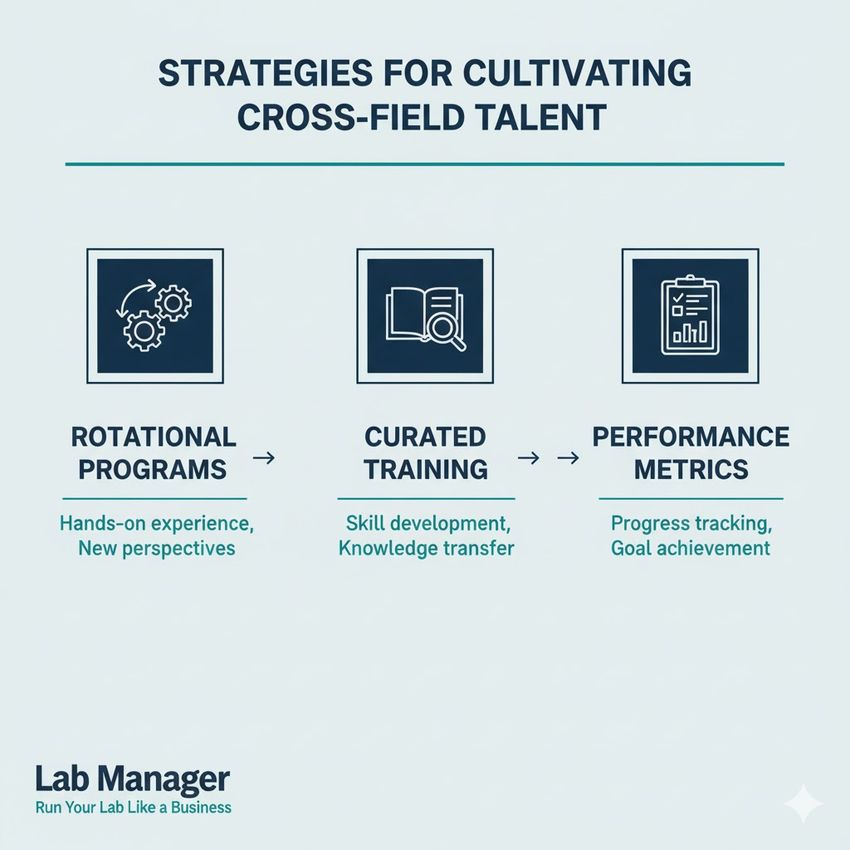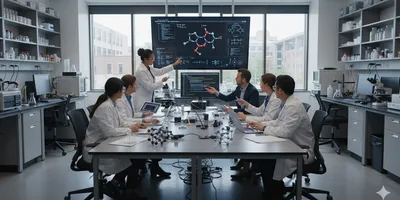Advancing the frontiers of modern engineering and technology relies heavily on successful multidisciplinary materials research. The development of novel materials—from high-performance composites to bio-integrated devices—requires synthesizing expertise from fields such as chemistry, physics, engineering, and computational science. For materials science labs and lab leadership seeking to maximize innovation and resource utilization, implementing a structured strategy for multidisciplinary materials research is essential. This integration moves beyond simple co-location, demanding dedicated planning across organizational, technical, and human resource dimensions.
Establishing Integrated Collaboration Frameworks for Materials Science
Achieving success in multidisciplinary materials research necessitates clearly defined organizational structures that foster genuine collaboration rather than simple co-existence. The primary goal is to break down traditional silos between disciplinary groups, such as polymer chemists, mechanical engineers, and quantum physicists, who often operate within the same facility but lack formalized interaction pathways.
Establishing shared governance models ensures that strategic decisions and resource allocations benefit the entire multidisciplinary materials research portfolio, not just individual departments. This approach aligns individual project goals with overarching organizational objectives, particularly when the end product—the material itself—is the result of inputs from multiple scientific domains. Regular, mandated cross-functional meetings, jointly-hosted seminars, and rotational assignments for technical staff are effective mechanisms for bridging knowledge gaps and building institutional memory across diverse research areas.
When defining these frameworks, specific mechanisms should be prioritized:
- Joint Project Initiation: Projects focused on multidisciplinary materials research must have joint principal investigators from different scientific backgrounds from the conceptual phase onward.
- Cross-training Mandates: Technical staff requires training on adjacent instrumentation and foundational principles outside their primary domain to improve intellectual flexibility and operational resilience.
- Shared Metric Development: Success metrics should reflect the collaborative nature of the work. Examples include joint patent submissions, co-authored publications across different disciplinary journals, and efficiency gains in shared resource utilization.
Implementing these frameworks requires lab leadership to actively champion the culture of integration, ensuring that efforts in multidisciplinary materials research are properly incentivized and rewarded.
Standardizing Data Management and Interoperability
Effective multidisciplinary materials research generates vast, heterogeneous datasets, including spectroscopic results, mechanical testing parameters, computational modeling outputs, and synthesis records. The heterogeneity of this data presents a significant hurdle to rapid discovery and validation.
To overcome this, a unified data strategy focused on interoperability is paramount. Implementing the FAIR (Findable, Accessible, Interoperable, Reusable) data principles specifically for material data enables researchers from different fields to seamlessly access, understand, and reuse data generated by their colleagues. A standardized metadata schema that captures key parameters—such as material composition, synthesis conditions, and measurement environment—ensures consistency across diverse data streams.
Adopting the Materials Genome Initiative (MGI) principles, which promote the integrated use of computation, experiment, and data infrastructure, provides a strong foundation for managing this complexity. This approach transforms raw data into actionable knowledge that drives future experiments and models.
Key Technical Pillars for Multidisciplinary Data:
Data Pillar | Description | Impact on Materials Research |
|---|---|---|
Standardized Metadata | Use shared ontologies and terminology (e.g., specific chemical identifiers, crystal structures) across all data-generating platforms. | Facilitates automated data integration and searchability across chemistry and physics data streams. |
Centralized Repository | Deploy a unified, cloud-based platform for all experimental and computational data. | Eliminates data silos, enabling engineers to access synthesis data instantly. |
Interoperable File Formats | Prioritize open, machine-readable formats (e.g., HDF5, JSON) over proprietary instrument files. | Improves the efficiency of integrating experimental results into computational models. |
Version Control | Implement strict tracking of data iterations linked to specific material batches and protocols. | Essential for ensuring reproducibility and auditability, a core requirement in regulated environments. |
Effective management of data, especially within larger multidisciplinary materials research programs, often requires a dedicated data curation team that bridges the language divide between IT specialists and scientific researchers. ref 1
Optimizing Shared Infrastructure and Resource Allocation
Multidisciplinary materials research often relies on expensive, specialized infrastructure, such as high-resolution electron microscopes, advanced synthesis reactors, and high-performance computing clusters. Optimizing the utilization of these shared resources is a significant logistical challenge but is crucial for cost efficiency and project timeliness.
A robust operational strategy involves centralizing the scheduling and maintenance of major equipment used across various disciplines. This necessitates not just a shared calendar, but transparent priority rules agreed upon by all participating groups, ensuring fairness and maximizing throughput.
Furthermore, integrating protocols and standard operating procedures (SOPs) is vital. While a chemist and a physicist might use the same instrument for vastly different experiments, a harmonized set of instrument preparation, calibration, and maintenance SOPs ensures reliable performance and reduces downtime. This also standardizes the quality of data output, which directly supports the interoperability goals of multidisciplinary materials research.
Advanced Lab Management Certificate
The Advanced Lab Management certificate is more than training—it’s a professional advantage.
Gain critical skills and IACET-approved CEUs that make a measurable difference.
This resource strategy must also extend to the budget. Funding models should move away from strict departmental allocation toward pooled budgets for shared assets, reinforcing the commitment of lab leadership to integrated multidisciplinary materials research. This includes dedicated funding for preventative maintenance and technician cross-training to support the diverse applications of the shared equipment.
Strategic Talent Development for Interdisciplinary Expertise
The success of any multidisciplinary materials research initiative ultimately depends on the skills and organizational culture of the personnel. Finding or developing "T-shaped" individuals—those with deep expertise in one field (the vertical bar) and broad proficiency across adjacent disciplines (the horizontal bar)—is a strategic imperative for materials science labs.
Lab leadership must develop a talent pipeline that rewards interdisciplinary aptitude. This starts with recruitment, actively seeking researchers who demonstrate fluency in multiple scientific languages (e.g., comfortable discussing both DFT calculations and synthetic yield).
Internal development programs are equally important. Creating structured mentorship pairs, where a senior engineer mentors a junior chemist on process scaling, and vice versa, can organically grow T-shaped talent. Furthermore, hosting internal symposia where researchers are required to present their work to non-specialist audiences promotes communication skills essential for effective multidisciplinary materials research. Investing in continuous professional development that focuses on computational methods for experimentalists and vice versa is a direct way to build this hybrid expertise.

Training staff in multi-disciplinary research is no easy task.
GEMINI (2025)
Strategies for Cultivating Interdisciplinary Talent:
- Rotational Programs: Implement short-term internal rotations for technical staff between synthesis and characterization groups.
- Curated Training: Offer workshops focused on bridging specific disciplinary gaps, such as "Machine learning for spectroscopic data analysis" or "Scale-up principles for materials scientists."
- Performance Metrics: Include metrics related to cross-functional collaboration and knowledge sharing in annual performance reviews.
By investing in human capital with a multidisciplinary materials research mindset, materials science labs secure their long-term capacity for innovation. According to the Materials Genome Initiative Strategic Plan, the ability to synthesize experimental and computational expertise remains the single greatest bottleneck to accelerated material discovery, underscoring the urgency of this development.
Fostering a Culture of Collaborative Materials Innovation
Sustained excellence in the field relies on a proactive strategy for nurturing a truly collaborative environment. By formalizing organizational structures, implementing unified data standards, optimizing resource sharing, and cultivating hybrid talent, materials science labs can transform disparate disciplinary efforts into a powerful engine for multidisciplinary materials research. Adopting these integrated strategies ensures that research efforts remain agile, efficient, and capable of addressing the complex material challenges of the future.
Frequently Asked Questions (FAQ)
What is the primary benefit of adopting a multidisciplinary approach in materials science?
The primary benefit of adopting a multidisciplinary materials research approach is the acceleration of discovery cycles. By integrating computational modeling, synthesis, and characterization expertise, researchers can quickly iterate on material design, reducing the time and cost required to transition from theoretical concept to functional material.
How does multidisciplinary materials research impact data management practices?
It necessitates a move toward mandatory data standardization and the implementation of FAIR principles. Data generated from distinct instruments and methodologies must share a common, machine-readable metadata schema to ensure true interoperability and enable computational analysis across diverse datasets.
What organizational structure best supports effective multidisciplinary materials research?
Organizational structures that employ shared governance, pooled resource allocation, and require joint principal investigators for projects are most effective. This moves decision-making away from individual department silos and centers it around the material development lifecycle itself, reinforcing the collaborative nature of multidisciplinary materials research.
This article was created with the assistance of Generative AI and has undergone editorial review before publishing.













